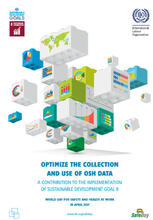EU-OSHA Blog
Back to latest postsWorld Day for Safety and Health at Work

April 28 is World Day for Safety and Health at Work. The theme this year is “optimise the collection and use of occupational safety and health (OSH) data”[1].
Reliable, high quality data is essential at both the workplace and policy levels to ensure that the correct decisions are made to ensure the ongoing protection of workers.
An interesting study of the challenges facing occupational safety and health policy-makers as a result of inadequate data was published in 2015, looking at the reporting of work-injuries in the Baltic Sea Region[2]. Subtitled “what goes unreported goes unfixed”, the report examined the incidence of fatal and non-fatal accidents, noting that a high rate of fatal work injuries in combination with a low rate of nonfatal work injuries suggests that much of the non-fatal work injuries have remained unregistered. The results of the order-of-magnitude analyses indicate that in several Baltic Sea countries it was likely that there was underreporting of non-fatal work accidents.
The report notes that “As a consequence of severe under-reporting of work injuries, the decision makers of many BSN countries may have at their disposal seriously deceptive statistical information when setting policy objectives, estimating economic loss, or defining priorities on the national agenda.”
Lack of quality data can also be a problem at workplace level. The small size of most enterprises may mean that there is a lack of accident data for employer to consider, and ill-health data may only appear long after the worker has been exposed to harm. Employers need to have strong, reliable indicators of health and safety performance. These key performance indicators (KPIs) have been considered in an article on the EU OSHA OSHWiki.[3]
These KPIs need to be relevant for the manager, relevant to occupational safety and health performance, and be communicable.
By relevant for the manager, the KPIs need to be useful as a basis for decision-making. These may be lagging (past performance) indicators – such as accident frequency data – or leading indicators (predictive) – such as number of workplace inspections, percentage of workers with adequate OSH training.
The indicators clearly need to be relevant to occupational safety and health. They can be quantitative or semi-quantitative, relating to hazards, risks, exposures, and preventive activities. These indicators may well be based on the findings of the risk assessment, such as identification of substances used and worker exposures, or examination of the ergonomics of workstations.
Finally, the KPIs need to be communicable and usable, to make decisions and to convey to workers and managers why actions are being taken. This need for communicability can lead to the use of simple indicators but these can fail to reflect the complexity of the occupational safety and health management system.
What is clear is that all decision-makers in occupational safety and health, whether at policy level or workplace level need decent data to ensure decent work, and that such data may be difficult to identify and access. This challenge needs to be addressed by all OSH professionals.
[2] Severe Under-reporting of Work Injuries in Many Countries of the Baltic Sea Region: An exploratory semi-quantitative study Kari Kurppa, MD, PhD Finnish Institute of Occupational Health Helsinki 2015 http://www.balticseaosh.net/wp/wp-content/uploads/2015/10/Severe-Under-reporting_final-report_Kurppa.pdf
[3] Key indicators Gerard Zwetsloot, TNO, The Netherlands https://oshwiki.eu/wiki/Key_performance_indicators accessed 6/2/17
